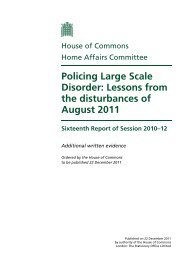Murder and Serious Sexual Assault - Lancaster EPrints - Lancaster ...
Murder and Serious Sexual Assault - Lancaster EPrints - Lancaster ...
Murder and Serious Sexual Assault - Lancaster EPrints - Lancaster ...
Create successful ePaper yourself
Turn your PDF publications into a flip-book with our unique Google optimized e-Paper software.
UNUSUAL PREVIOUS OFFENCES<br />
One general observation about this analysis of the murder cases (though there are<br />
exceptions) is that these unusual offences often involve persons who go on to<br />
murder in their 30s <strong>and</strong> perhaps early 40s 12 . In contrast, most murder involves<br />
persons who are convicted in their 20s.<br />
Offenders convicted of SSA<br />
In Chapter 3, there were five offences identified as unusual but highly significant in<br />
distinguishing SSA cases from the general criminal controls. These five offences are<br />
now examined in three groups: first, those convicted of kidnapping; secondly, those<br />
with a previous conviction for cruelty to/neglect of children; <strong>and</strong>, finally, those with<br />
a previous sexual offence.<br />
In total, 13 sexual assault cases <strong>and</strong> eleven controls had kidnapping in their history.<br />
As the expectation was that there would be around 52 controls with kidnapping in<br />
their previous criminal history, kidnapping convictions are clearly a risk factor for<br />
subsequent serious sexual offending.<br />
All 13 offenders convicted of kidnapping who went on to be convicted of SSA had<br />
a first conviction aged 23 or under. However, ages for conviction of SSA varied: five<br />
were aged 25 years or below, five were in their 30s, <strong>and</strong> three were in their 40s. The<br />
relationship between age at conviction for kidnapping, length of sentence <strong>and</strong> age<br />
at subsequent conviction for SSA is shown for all 13 cases in Table 12. It is worth<br />
considering the actual periods ‘at risk’ in the community. So, for example, case A<br />
was convicted of kidnapping (<strong>and</strong> other offences, including robbery) at the age of 34<br />
for which he was awarded a sentence of ten years’ imprisonment, <strong>and</strong> was convicted<br />
of rape at the age of 44. While the time between the kidnapping conviction <strong>and</strong> the<br />
rape conviction was ten years, case A would have spent much of the time between<br />
these events in prison (as a result of the initial sentence for kidnapping <strong>and</strong> the time<br />
taken to process Case A through the criminal justice system for the conviction of<br />
rape). The ten-year gap between the kidnapping <strong>and</strong> the rape offence exaggerates<br />
the genuine time ‘at risk’.<br />
35<br />
12 Owing to the construction of the<br />
sample, it is not possible to have<br />
anyone aged more than 44 years<br />
in the series.
















